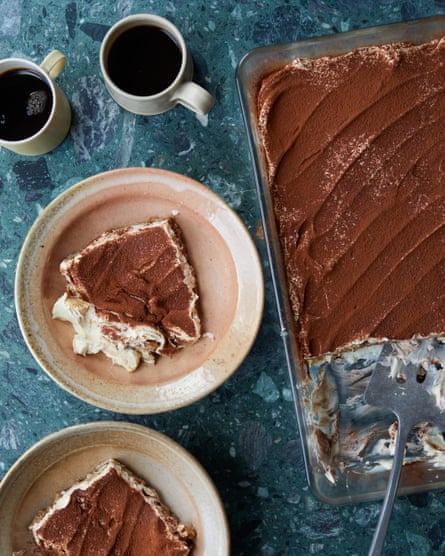Italian cuisine so often references old times; I love simple food and forgotten tales, too, but I also feel the need to escape this tradition. We opened our restaurant, Trattoria della Gloria, in Milan in 2023, and instinctively refused to spend every night selling a remote and often fictional past. Instead, we explore and experiment with ancient gestures, methods and pairings to create “new old things”. That is, dishes that our grannies could have made, but didn’t.
Green beans carbonara (pictured top)
Italy is no country for sauces – most of our meat, fish and vegetable dishes are usually served by themselves, or with just olive oil and little else. Italian sauces do exist, but they are held in captivity by pasta dishes. Carbonara, say, has become a very serious matter, calling for nothing but guanciale (cured pork cheek) and pecorino romano. It’s good, but it’s actually a very recent “tradition”: as a child in north Italy in the 1990s, I had never even heard of guanciale, and our carbonara was just fine.
Prep 30 min
Cook 30 min
Serves 4, as a side or light lunch
200g guanciale, or unsmoked pancetta
1 egg plus 3 egg yolks
100g grated pecorino romano, or parmesan, plus extra to finish
800g green beans, tailed
Sea salt and black pepper
Cut the guanciale (or most likely pancetta) into 5mm strips or cubes and put them in a cold, nonstick frying pan. Turn on the heat to low, then slowly heat up the meat (with no oil), tossing or stirring every now and then, for about eight minutes in total, until the fat starts to melt and the pieces of pork first turn translucent and then go crisp. Using a slotted spoon, transfer the fried guanciale/pancetta to a plate lined with paper towel, and take the pan off the heat, reserving the very hot fat.
In a bowl, whisk the egg, egg yolks, grated cheese and plenty of black pepper for a minute, then pour the hot fat over the top and mix it in very well. The result is essentially a hollandaise with cheese and pork fat (instead of the usual butter).
Fill a large pan with water, season with salt, bring to a boil, then add the green beans and cook for six to nine minutes, according to how done you like them.
Drain the beans, then divide them between four plates. Taste the sauce and add salt, if need be (unlikely); if it looks a little too thick, loosen with a spoonful of the bean cooking water. Pour the sauce all over the beans, top with the crisp guanciale and more grated cheese and black pepper, then serve.
Leftover bread tiramisu

Savoiardi or boudoir biscuits are often hard to find, but you need them to make tiramisu. That’s why I gave up on them years ago, both at home and at the restaurant, and now I use leftover bread instead. The original name for french toast was pain perdu, meaning “lost bread”, which makes this tiramisu perduto.
Prep 25 min
Cook 15 min
Rest 20 min
Assembly 10 min
Serves 8
6-8 1cm-thick slices 1- to 2-day-old sourdough, crusts left on
500ml whole milk
100g caster sugar, plus 20g extra for dusting
200ml brewed strong coffee
500g fridge-cold mascarpone
500ml fridge-cold whipping cream
Cocoa powder, for dusting
Heat the oven to 200C (180C fan)/390F/gas 6. Put the sourdough slices on a deep tray, cover with the milk, dust with the 20g caster sugar, then roast for about 15 minutes, until just golden. At this point, the bread should be rising like a very rustic cake. Take it out of the oven and leave to cool to room temperature for about 20 minutes.
Once the bread has cooled, pour the coffee all over it and gently turn the slices so they soak up the coffee entirely and you don’t end up with any chewy corners.
Meanwhile, make the mascarpone cream. Whisk the mascarpone, 100g sugar and 100ml whipping cream for 30 seconds, then add the remaining cream and beat again, this time slowly, for about 10 minutes, until the cream turns stiff but is still smooth.
Using a large spatula, spread half the cream mix over the bottom of a deep, roughly 24cm x 35cm x 5cm glass dish. Using your hands, drain the bread and use it to cover the layer of cream. Dust with cocoa powder, then cover the bread with the remaining cream. The tiramisu doesn’t really need to rest, but an hour in the fridge will be fine. Just before serving, dust with more cocoa powder.
-
Tommaso Melilli is chef and co-owner of Trattoria Della Gloria in Milan

 1 month ago
52
1 month ago
52

















































